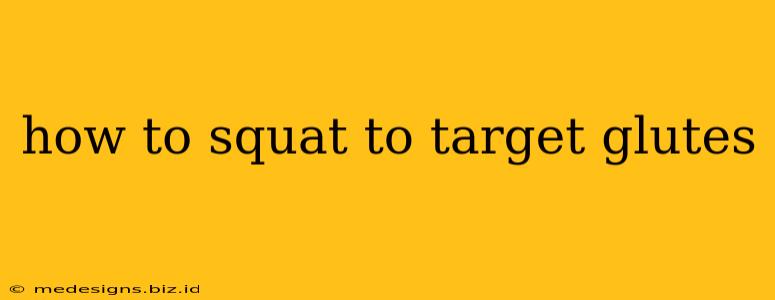Want a peachy, powerful backside? Squats are your secret weapon, but technique is key! Many people perform squats incorrectly, focusing on quads instead of glutes. This comprehensive guide will show you how to modify your squat form to maximize glute activation and build the strong, shapely glutes you desire.
Understanding Glute Activation in Squats
Before diving into the specifics, let's understand why some squats target glutes more than others. It boils down to these factors:
- Hip Hinge: The squat is not just a leg exercise; it's a hip-dominant movement. Proper hip hinge emphasizes glute involvement. Think of pushing your hips back as if you're sitting in a chair.
- Depth: A deeper squat generally recruits more glute fibers. However, going too deep without proper form can lead to injury.
- Foot Placement: Your foot placement significantly impacts muscle activation. A slightly wider stance and externally rotated feet (toes slightly pointed out) are typically ideal for glute activation.
- Weight and Resistance: While bodyweight squats are effective, adding weight, such as dumbbells or a barbell, increases the challenge and glute recruitment.
Mastering the Glute-Focused Squat: A Step-by-Step Guide
Here's a detailed breakdown of how to perform a squat that prioritizes glute activation:
1. Proper Stance and Posture:
- Foot Placement: Stand with feet slightly wider than shoulder-width apart, toes pointed slightly outwards (about 15-30 degrees). This externally rotated position allows for better hip mobility and glute activation.
- Posture: Keep your back straight, engaging your core muscles for stability. Avoid rounding your back, which can put strain on your spine. Imagine a straight line from your head to your heels.
2. The Descent: The Hip Hinge
- Initiate the movement by pushing your hips back, as if you're sitting back into a chair. This is crucial for glute activation. Don't focus on bending your knees first.
- Maintain a straight back and keep your chest up. Your knees should track over your toes; avoid letting them cave inwards.
- Descent Depth: Squat down until your thighs are parallel to the ground, or slightly lower if your mobility allows. Avoid bouncing at the bottom.
3. The Ascent: Power Through Your Glutes
- Drive through your heels to return to the starting position. Focus on using your glutes to power the movement upward.
- Squeeze your glutes at the top of the movement to maximize muscle activation. Hold this contraction briefly before starting the next repetition.
4. Breathing:
- Inhale as you descend and exhale as you ascend. This controlled breathing pattern helps maintain stability and maximizes power.
Variations for Advanced Glute Training:
Once you've mastered the basic glute-focused squat, you can incorporate variations to challenge your muscles further:
- Barbell Back Squats: Adding weight significantly increases the resistance and muscle recruitment.
- Goblet Squats: Holding a dumbbell or kettlebell close to your chest allows for better balance and core engagement.
- Sumo Squats: A wider stance with toes pointed outwards further emphasizes glute activation.
- Bulgarian Split Squats: This single-leg variation increases balance challenges and targets each glute individually.
Common Mistakes to Avoid:
- Rounding your back: This puts undue stress on your spine and reduces glute activation.
- Knees caving inward: This can lead to knee pain and limits glute involvement.
- Not going deep enough: A shallower squat recruits fewer glute fibers.
- Looking down: Keep your gaze slightly forward or upward to maintain good posture.
Conclusion: Sculpt Your Glutes with Perfect Form
By following these guidelines and consistently practicing your glute-focused squats, you'll be well on your way to achieving the strong, sculpted glutes you've always wanted. Remember that consistency and proper form are key to seeing results! Listen to your body, and don’t hesitate to modify the exercises to suit your fitness level and any specific physical limitations. Happy squatting!
